Sold Ceramics
Sold Japanese Imari 1690-1800
'Gold' Imari
Page 2
A group that seems to have been especially favoured in The Netherlands, traditionally called 'Gold Imari', dates to the early 18th century. These wares are painted in gold only, in gold and iron-red, or in gold and red with a few touches of green, aubergine and black. 'Gold Imari' is relatively well represented in collections in the northern parts of The Netherlands but which occurs less often in old English and German collections
From about 1700 the gold often has a pink-violet hue ('pink lustre'), which is clearly visible on the white porcelain background when the gold is very thin or has been rubbed off. It seems that the Japanese enamellers used a different process to the Chinese, because Chinese pieces do not have this pink violet hue. (Jörg 2003/1, pp.92-93
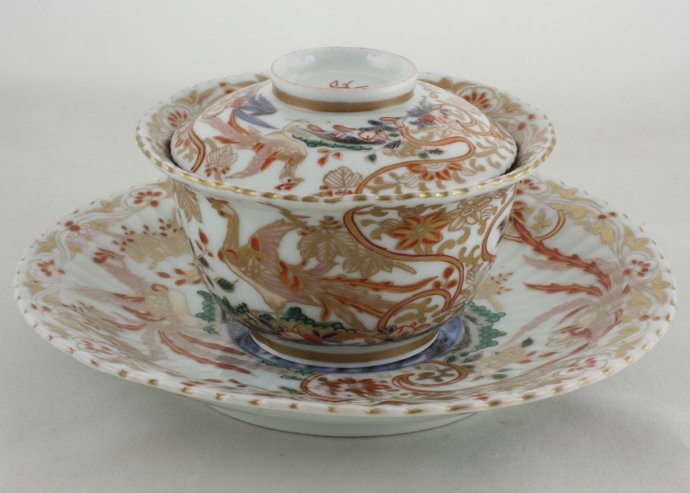
Sold Ceramics - Sold Japanese Imari 1690-1800 - 'Gold' Imari - Page 2
Object 2012322
Bowl with cover and stand
Japan
1710-1730
Dish: height 33 mm (1.29 inch), diameter of rim 180 mm (7.09 inch), diameter of footring 92 mm (3.62 inch), weight 298 grams (10.51 ounce (oz.))
Bowl (without cover): height 60 mm (2.36 inch), diameter of rim 112 mm (4.41 inch), diameter of footring 50 mm (1.97 inch), weight 150 grams (5.29 ounce (oz.))
Cover: height 24 mm (0.94 inch), diameter of rim 92 mm (3.62 inch), diameter of ring 35 mm (1.38 inch), weight 70 grams (2.47 ounce (oz.))
Ribbed dish on footring, everted lobed rim. Bowl on footring, steep sides with spreading lobbed rim. the ribbed cover with ring and lobed rim. 'Gold' Imari decorated in underglaze blue and overglaze iron-red, green, gray and black enamel and gold. The dish with a central design of a zigzag plank bridge in a garden landscape with various flowering plants and clouds in underglaze blue with outlining in gold. On the sides and rim cloud-like partitions with flower sprays, foliate scrolls alternating with paulownia branches and two phoenixes one standing and one in flight. On the reverse three fruiting 'Buddha's hand citron' (Citrus medica) or finger lemon fruit, peach and pomegranate sprays. The bowl and cover are decorated en suite.
This type of decoration is traditionally called 'gold' Imari because of the lavish use of gold, on this bowl it is combined with overglaze green enamel, black and iron-red. (Jörg 2003/1, p.112)
An identically shaped, sized and decorated bowl with cover and stand is in the collection of Oriental ceramics in the Groninger Museum.
For an identically shaped and similarly decorated bowl and saucer without the underglaze blue decoration and without the cover, please see:
- Fine & Curious. Japanese Export Porcelain in Dutch Collections, (C.J.A. Jörg, Hotei Publishing, Amsterdam, 2003), p.112, cat. 118 & 118a.
-
Sold Ceramics - Sold Japanese Imari 1690-1800 - 'Gold' Imari - Page 2 - Objects 2010612 & 2010406.
For identically decorated bowls without underglaze blue decoration, please see:
- Oosters porselein. Delfts aardewerk. Wisselwerkingen, (C.J.A. Jörg, Groningen, 1983), p.27, cat. 11.
- Mistrovská dĩla Japonského porcelánu / Masterpieces of Japanese Porcelain, (F. Suchomel, Prague 1997), pp.136-137, cat. 178.
Condition:
Dish: Perfect.
Bowl: A short firing tension hairline to the base, caused by the firing process.
Cover: Perfect.
References:
Price: Sold.
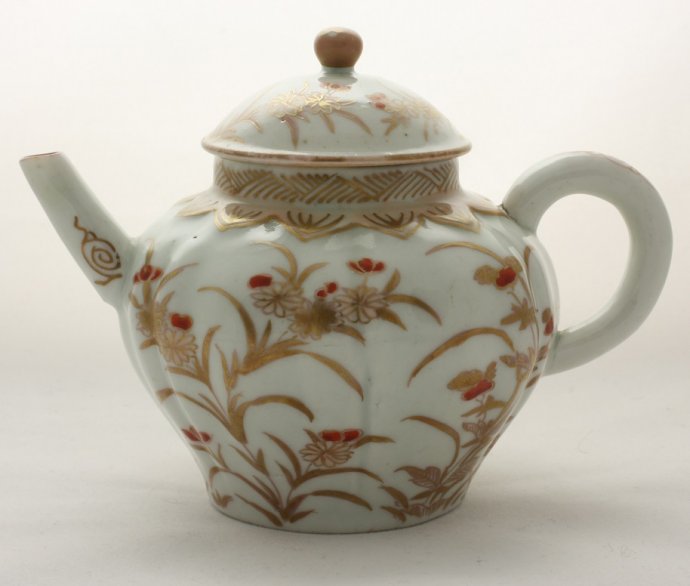
Sold Ceramics - Sold Japanese Imari 1690-1800 - 'Gold' Imari - Page 2
Object 2010282
Teapot
Japan
1710-1730
Height with cover 92 mm (3.62 inch), diameter handle to spout 130 mm (5.12 inch), diameter of footring 50 mm (1.97 inch)
Teapot on footring, ribbed body, curved handle with straight spout, 'Gold' Imari, decorated in gold, iron-red and a pink-gold wash with groups of flowering chrysanthemum plants, around the shoulder lotus petals in a low relief . Around the neck a zig-zag lines border. On the cover flowering chrysanthemum plants and on the spout and handle spiral motifs.
Condition: Firing flaws to the handle and mouthrim and a very tiny shallow chip to the mouthrim.
Price: Sold.

Sold Ceramics - Sold Japanese Imari 1690-1800 - 'Gold' Imari - Page 2
Object 2012143
Teacup and saucer
Japan
1710-1715
Height of teacup 39 mm (1.53 inch), diameter of rim 73 mm (2.87 inch), diameter of footring 29 mm (1.14 inch), weight 42 grams (1.48 ounce (oz.))
Height of saucer 38 mm (1.50 inch), diameter of rim 116 mm (4.57 inch), diameter of footring 62 mm or (2.44 inch), weight 91 grams (3.21 ounce (oz.))
Teacup on footring and saucer on a wide flat unglazed footring with three small outward turned tapering feet ending in a globule, lobed sides and everted fluted rims. 'Gold' Imari, decorated in gold, iron-red and a light-pinkish gold wash with a single flower spray on the sides and reserves filled with flowering plants alternating with a pagoda near a pine tree in a mountainous landscape. The reverse is undecorated. The teacup is decorated en suite.
The saucer with small feet is very unusual. Apparently, no other published examples are known, which makes this an extremely rare set. At first it was considered that the saucer might in fact have been a leak tray for a milk jug or a small teapot and that the teacup together with a matching saucer, without three small feet, once belonged to the same tea service.
Delving some more into the occurrence of ‘small feet’ in Japanese porcelain, various larger Japanese porcelain objects came to light with all kinds of differently shaped feet or legs. Recorded in literature are items such as kakiemon incense burners (koro) (Impey 2002, cat. 272; Ayers, Impey & Mallet 1990, cat. 104; Arts 1983, cat. 35), Imari boxes with covers (Jörg 2003/1 cat. 103, 105, 106; Arita 2000, cat. 216) [, a blue and white tripod dish (Kyushu 1998, p.53, cat. 84) and even larger and rare milk bowls, probably made after European earthenware models (Jörg 2003/1, cat. 212/213; Arita 2000, cat. 123 t/m 125).
More comparable because of its small size is an odd Ko-Imari pouring vessel with gilded handles and tripod feet in the collection of Burghley House (The Burghley Porcelains ,1986, p. 264, cat. 116)
However, even more interesting for comparison is a kakiemon saucer (diameter 124 mm (4.88 inch)) with three bracket-feet, which was surely at one time accompanied by a matching cup. When discussing this saucer Impey states that while larger pieces with bracket-feet are well known, they are very rare in this small size (Impey 2002, p. 166 cat. 255; The Burghley Porcelains, 1986, p. 258 cat. 112).
Another kakiemon tripod saucer dish (diameter 145 mm (5.70 inch)) with outward turned feet which resemble the ones on this set very closely, can be found at McPherson Antiques, London, sold stock number 23696.
Unexpectedly, two other 'Gold' Imari teacups and tripod saucers came to light, both decorated with the well-known quail pattern, clearly proving that this set doesn’t stand on its own but has other counterparts, rare as they may be. These three sets, all yet to be published, are part of two distinguished British private collections. Two of these sets may be shown here for comparison.
Two Japanese 'Gold' Imari teacups with legged saucers, c.1710-20, private British collection (not included in this sale).
These unusual and very rare sets must have been part of a private order, made in small series, most likely by a specialised kiln.
Condition:
Teacup: Perfect.
Saucer: Two tiny fleabites to the rim.
References:
The Burghley House Porcelains 1986, cat. 112 & 116
Ayers, Impey & Mallet 1990 , cat.104
Arita 2000, cat.123 t/m 125, cat. 216
Jörg 2003/1, cat. 103, 105/106, 212/213
McPherson Antiques, London, sold stock number 23696.
Price: Sold.

Sold Ceramics - Sold Japanese Imari 1690-1800 - 'Gold' Imari - Page 2
Object 2010600
Dish
Japan
c.1720
Height 53 mm (2.09 inch), diameter of rim 210 mm (8.27 inch), diameter of footring 119 mm (4.69 inch), weight 671 grams (19.43 ounce (oz.))
Sixteen-lobbed dish on footring with spreading sides and a lobbed rim. On the base four spur-marks in a Y-pattern. 'Gold' Imari, decorated in overglaze gold, iron-red and a light pinkish gold wash with various flowering chrysanthemums in a circle. Round the foot of the cavetto a petalled circle. On the cavetto seven stylised golden chrysanthemum flower heads outlined in red with white centres (some in low relief) are scattered across all the panels. The reverse with four camellia flower heads surrounded by scrolling branches.
Condition: Wear to the decoration in the centre and on the sides, a tiny fleabite to the rim.
Price: Sold.
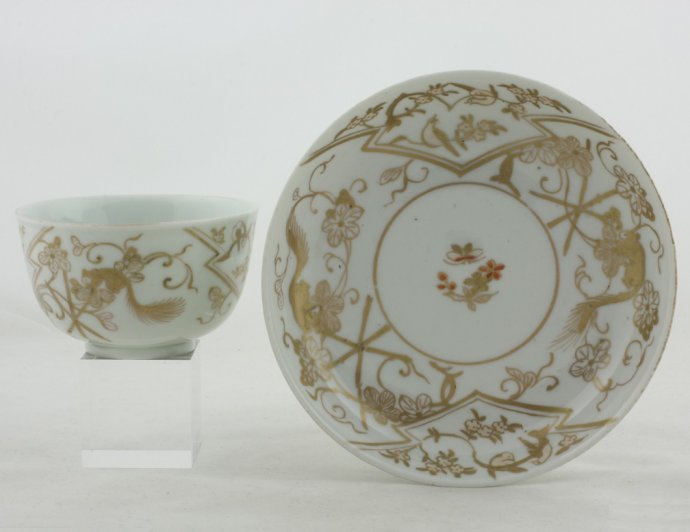
Sold Ceramics - Sold Japanese Imari 1690-1800 - 'Gold' Imari - Page 2
Object 2011630
Tea/coffee cup and saucer
Japan
1700-1730
Height of tea/coffee cup 51 mm (2.00 inch), diameter of rim 85 mm (3.35 inch), diameter of footring 37 mm (1.46 inch), weight 85 grams (3.00 ounce (oz.))
Height of saucer 30 mm (1.18 inch), diameter of rim 142 mm (5.59 inch), diameter of footring 68 mm or (2.68 inch), weight 147 grams (5.19 ounce (oz.))
Tea/coffee cup and saucer on footrings, slightly everted rims. 'Gold' Imari, decorated in gold, iron-red and a light-pinkish gold wash with a flower spray with a butterfly in flight in a central roundel surrounded by a squirrel climbing through flowering branches growing from three crossed bamboo sticks, alternating with a panel filled with two birds perched on a flowering branch, the reverse is undecorated. Th teacup is decorated en suite.
This tea/coffee cup and saucer is of a size suitable for tea as well as coffee. (Jörg 2003/1, p.201)
Similar shaped and in 'Gold' Imari decorated large tea/coffee cups and saucers (with another design) are in the collection of the Groninger Museum, please see:
- Fine & Curious: Japanese Export Porcelain in Dutch Collections, (C.J.A. Jörg, Hotei Publishing, Amsterdam 2003), pp.200-201, object 256.
For a dish decorated with the 'squirrel and vine' design in underglaze blue, please see:
For a double gourd ewer decorated with the 'squirrel and vine' design in Kakiemon enamels, please see:
- Japanese Porcelain, (S. Jenyns, Faber & Faber, London / Boston, 1979), cat. 58a.
- Complete Catalogue of the Shibata Collection, (The Kyushu Ceramic Museum, Kyushu 2003), p.244, cat. 1889.
The 'squirrel and vine' design also occurs on Chinese export porcelain objects, for a baluster shaped vase decorated with this design, please see:
Condition:
Tea/coffee cup: Perfect.
Saucer: Perfect.
References:
Price: Sold.

Sold Ceramics - Sold Japanese Imari 1690-1800 - 'Gold' Imari - Page 2
Object 2012109
Dish
Japan
1700-1720
Height 34 mm (1.33 inch), diameter of rim 213 mm (8.35 inch), diameter of footring 107 mm (4.21 inch), weight 425 grams (14.99 once (oz.)),
Dish on footring, everted lobed rim. On the base three spur-marks in a V-pattern. 'Gold' Imari, decorated in gold, iron-red and a light-pinkish gold wash. In the centre a pair of quails near a shore under a millet plant. On the sides peony flower heads with foliage alternating with a butterfly in flight. On the rim flower heads alternating with leaves. The reverse is undecorated.
A group that seems to have been especially favoured in The Netherlands, traditionally called 'Gold Imari', dates to the early 18th century. These wares are painted in gold only, in gold and iron-red, or in gold and red with a few touches of green, aubergine and black. 'Gold Imari' is relatively well represented in collections in the northern parts of The Netherlands but which occurs less often in old English and German collections
From about 1700 the gold often has a pink-violet hue ('pink lustre'), which is clearly visible on the white porcelain background when the gold is very thin or has been rubbed off. It seems that the Japanese enamellers used a different process to the Chinese, because Chinese pieces do not have this pink violet hue. (Jörg 2003/1, pp.92-93)
The quail, closely allied to the partridge, is an emblem of courage both in China and Japan, as it is highly esteemed as a fighting bird. In North China people made these birds fight under a basket, where millet first had been strewn to make them jealous. Moreover, quails are believed to change into pheasants eventually. On Japanese porcelain they are frequently depicted amidst autumn grasses under millet. This quail and millet design, symbolizing the autumn is especially common on Kakiemon, but is also found on ko Kutani, Imari and blue-and-white wares. It has been suggested that that particular form is copied from the work of the painter Tosa Mitsuoki (1607-1691), but it probably originated from Chinese paintings of the Sung period. This motif has been copied on European porcelain, especially at Bow and Chelsea, where it is used as a decoration on the so-called 'partridge plates', and also on Meissen porcelain. (Arts 1983, pp.134-135)
Condition: Two hairlines to the rim.
References:
Price: Sold.
More pictures of object 2012110, another, identically shaped. sized and decorated, sold, dish >>

Sold Ceramics - Sold Japanese Imari 1690-1800 - 'Gold' Imari - Page 2
Objects 2010612 & 2010406
Bowl and saucer
Japan
1710-1730
Height of bowl 70 mm (2.76 inch), diameter of rim 139 mm (5.47 inch), diameter of footring 59 mm (2.32 inch)
Height of saucer 23 mm (0.91 inch), diameter of rim 180 mm (7.09 inch), diameter of footring 95 mm (3.74 inch)
Bowl on footring with spreading lobbed rim. The inside ribbed. Matching ribbed saucer on footring, on the base a single spur-mark. The matching saucer was acquired at a later date. 'Gold' Imari, decorated in overglaze iron-red, green, black and gold.
The saucer with a central design of a pine tree and blossoming cherry with two birds perched on a branch surrounded by two groups of rocks, grasses and peonies. On the sides and rim cloud-like partitions with flower sprays, foliate scrolls, paulownia branches and two phoenixes in flight. On the reverse three fuiting 'Buddha's hand citron' (Citrus medica) or finger lemon fruit, peach and pomegranate sprays. The bowl is decorated en suite, but with one standing phoenix and one in flight.
This type of decoration is traditionally called 'gold' Imari because of the lavish use of gold, on this bowl it is combined with overglaze green enamel, black and iron-red. (Jörg 2003/1, p.112)
For an identically shaped and decorated bowl and saucer, please see:
For identically decorated bowls, please see:
- Oosters porselein. Delfts aardewerk. Wisselwerkingen, (C.J.A. Jörg, Groningen, 1983), p.27, cat. 11.
- Mistrovská dĩla Japonského porcelánu / Masterpieces of Japanese Porcelain, (F. Suchomel, Prague 1997), pp.136-137, cat. 178.
Condition:
Bowl: Perfect.
Saucer: Perfect.
References:
Price: Sold.
More pictures of object 2011311, another identically shaped, sized and decorated, sold bowl >>
More pictures of object 2012083, another identically shaped, sized and decorated, sold bowl >>
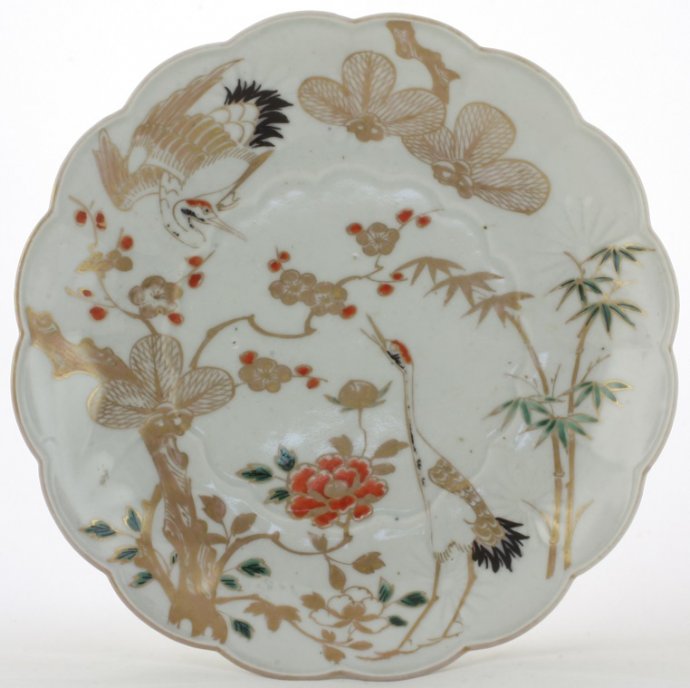
Sold Ceramics - Sold Japanese Imari 1690-1800 - 'Gold' Imari - Page 2
Object 2011443
Dish
Japan
1730-1740
Height 33 mm (1.30 inch), diameter of rim 201 mm (7.91 inch), diameter of footring 125 mm (4.92 inch)
Sixteen-lobbed dish on footring with spreading sides, a lobbed rim and a glazed base. On the base four spur-marks. 'Gold' Imari, decorated in overglaze iron-red, green, black and gold with two cranes, a blossoming peony and prunus, chrysanthemum leaves and a bamboo plant. Three flowering peony, chrysanthemum and prunus sprays to the reverse.
The crane is an auspicious symbol of longevity and a blessed life, a pair of cranes of a long and happy marriage. This type of decoration is traditionally called 'gold' Imari because of the lavish use of gold, on this dish it is combined with green and black enamel. (Jörg 2003/1, p.112 & p.185)
Both the Worcester and Derby factories in the UK copied this pattern or versions of it in the 18th century and Spode & Davenport in the 19th century. (Jenyns 1979, cat 45a)
For an identically shaped and decorated dish, please see:
Condition : Perfect, three unglazed spots, caused by the firing process, to the reverse.
References:
Price: Sold.
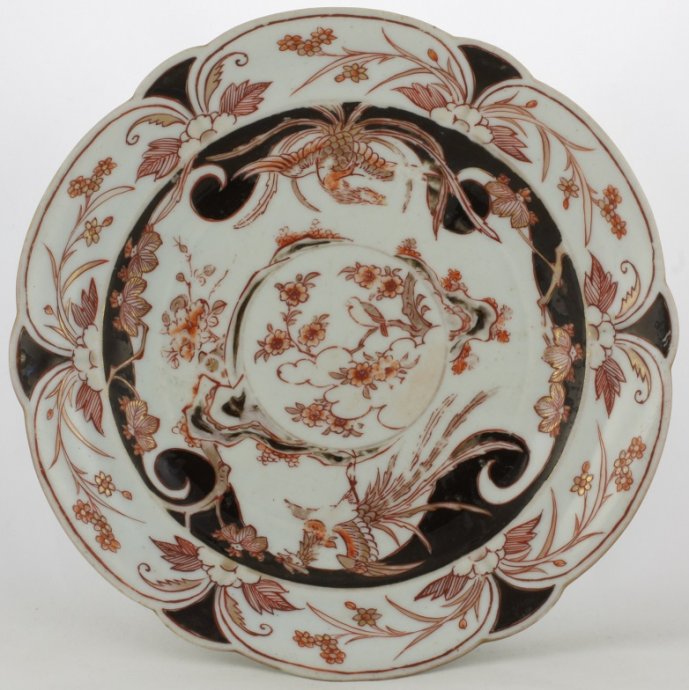
Sold Ceramics - Sold Japanese Imari 1690-1800 - 'Gold' Imari - Page 2
Object 2011695
Dish
Japan
1700-1720
Height 39 mm (1.54 inch), diameter 213 mm (8.39 inch), diameter of footring 113 mm (4.45 inch), weight 445 grams (15.70 ounce (oz.))
Dish on footring, spreading six-lobbed rim. On the base two spur-marks. 'Gold' Imari, decorated in iron-red, gold and black enamel with a central roundel filled with a bird perched on the branch of a flowering tree. The roundel is surrounded by two groups of rockwork one with a wide pine tree. On the sides two phoenixes one standing the other in flight under a wave-shaped border in black enamel. On the rim six half peony flower heads with reserves filled with flowering plants and divided by triangles in black enamel. On the reverse two flower sprays.
The intention of this black enamelling technique was to imitate lacquer, as lacquer adheres poorly to the porcelain body, this enamel imitation was a good alternative. (Jörg 2003/1, cat. 129 & 340)
For objects similarly decorated with black enamel / lacquer imitation please see;
- Early Japanese Porcelain: Arita Porcelain in the Dresden Collection, (F. Reichel, Londen 1981), cat. 55.
- Oosters Porselein. Een keuze uit de verzameling van het Museum Boymans-van Beuningen / Oriental porcelain. A choice from the Boymans-van Beuningen Museum Collection, (C.J.A. Jörg, Museum Boymans-van Beuningen, Rotterdam, 1995), pp.121-122, figure 55.
- Fine & Curious: Japanese Export Porcelain in Dutch Collections, (C.J.A. Jörg, Hotei Publishing, Amsterdam 2003), p.119, cat. 129 & pp.267-268, cat 340.
Condition: Some wear to the decoration, a firing flaw to the base, a popped bubble of glaze and a very tiny shallow glaze rough spot to the rim.
References:
Price: Sold.



 create websites
create websites